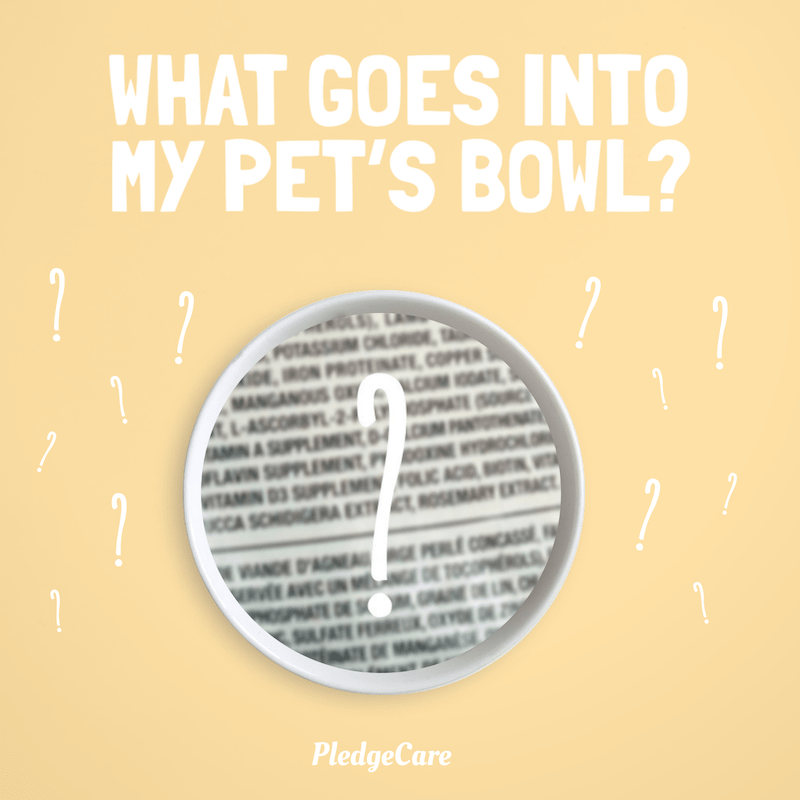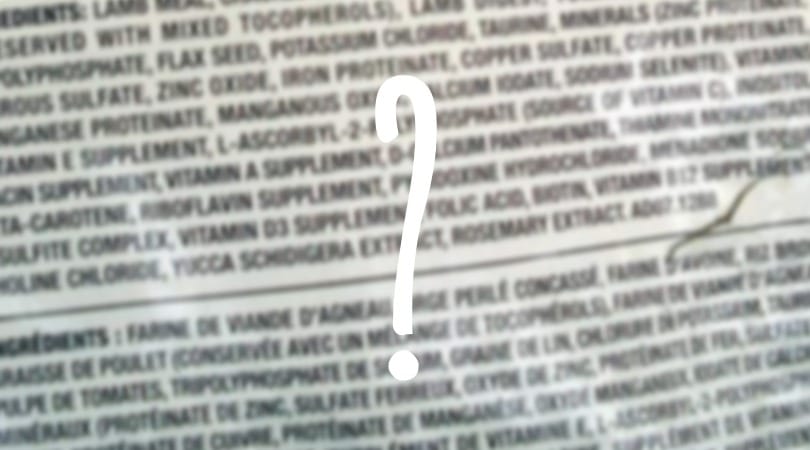At PledgeCare, we have a bone to pick with the commercial pet food industry. Have you ever looked at an ingredients label on a pet food bag and felt like you needed a degree in nutrition to decipher what actually goes into the food? So have we!
Unfortunately, many pet parents are being kept in the dark on what they are feeding their pets – which the article “Unlabeled horse, other animals found in European pet food” perfectly illustrates.
Missing pet food regulations make it possible for manufacturers to use a wide range of poor-quality ingredients. Ingredients like contaminated farming grains and 4D Meat -from (dead, dying, diseased, disabled) animals are both allowed in pet food products. Manufacturers can buy these at a fraction of the price since they are illegal to use in any human food.
Since most consumers would want to avoid these ingredients, many brands will use vague marketing claims and misleading ingredient-labels to hide what actually goes into the food. This has become a common practice among most brands, which makes it more and more difficult to know what actually goes into your furkid’s bowl.
In this article, we’ll teach you 5 labelling-tricks some pet food companies use:
1. First Ingredient
Even though an ingredient is listed on the top of the ingredient list, it doesn’t mean it makes up a significant part of the final kibble. Most companies know that consumers look for real meat on the label since it gives an impression of a meat-rich product. Sometimes this lies very far from the truth.
Example: Beef (20%), Rice (20%), Corn (20%), Split peas (10%), Pea protein (10%), Potato (10%), Potato starch (10%)
Even though meat is at the top of the ingredients it only makes up 20% of the full formulation. On top of this, beef is high in moisture which is lost during the cooking process. Most starch sources used are already dry which means they make up an even larger percentage of the food when it has been cooked. Keep an eye on a large number of different dry-carb sources (rice, corn, wheat, potato etc.) listed on the packaging as this can mean the food is very high in carbohydrates.
2. Protein percentage
Another thing many consumers are looking for is the percentage of protein in the pet food. Although, a higher protein level indicates more meat it’s not always the full story. An important factor is the source of protein used in the food.
The digestibility – the percentage of nutrition the body can utilize – varies greatly depending on which source is used. Fresh meats and eggs rank at the top while plant-protein sources can be significantly less digestible. Plant-protein like pea-protein and wheat gluten meal can significantly boost the overall protein content at low cost to the manufacturer.
If you’re wondering if your pet is getting their protein from the right sources, you can sometimes find the answer in the poop. Low digestibility put unnecessary stress on the digestive system. It will often result in larger stools since the nutrients can’t be absorbed properly.

3. “X% of protein from meat”
The source of protein has a great impact on digestibility – as discussed above. Some companies will list the amount of protein coming from meat on their package.
This is great information but it can also be used as a sneaky marketing trick to lure consumers into thinking they use more meat.
Example: 90% protein from meat, 10% fruit, 0% grains
At first glance, it might seem like they include 90% meat in their recipe which is often not the truth. Usually, it means the other ingredients are very low in protein (potatoes, rice, tapioca). Automatically, the protein comes from the meat.
Therefore, a pet food brand using the statement, “90% protein from meat”, can actually contain very little meat and have a low protein content and an overall poor nutritional value.
To have the above-mentioned claim, the manufacturers use very simple carb-sources with low protein content e.g tapioca. This causes a spike in your pups blood sugar and leads to a poor energy level throughout the day. In the long run, your dog risks getting various of health-diseases such as diabetes.
4. Grain Free
Claims like “Grain-Free” are seen on a lot of pet food products these days. Let’s take a look at why:
The popularity of grain-free products took off after the melamine recall in 2007. More than 3600 pets died following contamination of pet food ingredients. Previously, most people didn’t read pet food labels and didn’t think twice of which ingredients pet food brands used. Consumers trusted that the manufacturers would provide the best care of their dog. But after the recall, it became clear that most of the pet food ingredients were very unfit for dogs and cats to eat.
A lot of consumers demanded biologically appropriate foods that weren’t made with any grains, fillers or sketchy ingredients. As popularity grew, many low-quality brands launched grain-free lines to join the bandwagon. In order to keep the prices low, they included larger amounts of simple carbohydrates such as potatoes, tapioca and peas. Therefore, Even though the foods were “grain-free”, they weren’t much healthier than before.
Today more than 43% of all pet food sold in the USA is grain-free. However, only a small part is actually biologically appropriate for dogs.
Example: Some of the most popular Grain-Free brands still consist of up to 52% carbohydrates.
Going grain-free can be great – especially for dogs with specific allergies. But it’s important to know exactly what goes into the food. If grain-free works well for your dog be sure to check all the other ingredients as well.
5. “Complete and Balanced”
Various pet food packages contain the phrase “Complete and balanced by AAFCO standards.” The claim means the brands live up to some specific nutrient-values controlled by The Association of American Feed Control Officials.
Although the claim was created to help consumers find the right food, it creates some confusion.
Example: Two different brands use significantly different ingredients, but both can be listed as “Complete and balanced” since nutrients can be added artificially after processing.
Therefore, plenty of manufacturers still rely on fillers with extremely poor nutritional value. Why? Because it’s cheaper to add synthetic vitamin-mixes after.
But be careful!
Eating this is very similar to eating a diet consisting of 100% fast food plus a vitamin pill. Technically, you get the nutrients you need but most likely you will have less energy, more frequent illnesses and a higher risk of chronic health diseases.
The source of nutrients plays a bigger role than most people know. Some synthetic vitamins and minerals can have bioavailabilities as low as 4% and be hard on the organs because they can’t be properly digested.
Furthermore, AAFCO doesn’t cover a wide range of nutrients. In fresh whole foods, you find unique nutrients such as papain from papaya and curcumin from turmeric. Papain and curcumin are not included in most pet foods because these nutrients aren’t required by AAFCO. However, they act as a great health booster for your pet.
The PledgeCare way
In an industry riddled with vague claims and questionable ingredients, we decided to take a totally different approach. We only include fresh, natural human-grade ingredients in our pet food that serve as the backbone for great health. In fact, we are so proud of our ingredient-list that you’ll find it highlighted on the front of the packaging. Both you and your pet deserve that level of transparency.
Even if you’re not feeding PledgeCare, we think it’s important to have the right tools to know what goes into your furkid’s bowl. There’s still a lot that can be changed for the better in the pet food industry. We hope PledgeCare can move it in the right direction by spreading awareness and helping people pick the right food for their dogs and cats.
You can learn more about PledgeCare’s Air-Dried Pet Food here.
You may like:
- The Difference Between Kibble And Air-Dried Pet Food
- Coconut Oil in Dog Food
- The Best Pet Boarding in KL/PJ
PledgeCare’s blog posts are designed to help and inspire dog parents who wish a healthier every day for their dogs. If you’re curious about our air-dried raw, Malaysian, human-grade and super healthy dog food, check out: https://pledgecare.org


What about vegetarian dog food?
Pingback: Difference between kibble and air-dried pet food - PledgeCare
Pingback: The Best Dog-Friendly Places In KL & PJ - PledgeCare Malaysia
Pingback: The 3 Best Pet Boarding Centres in KL/PJ - PledgeCare